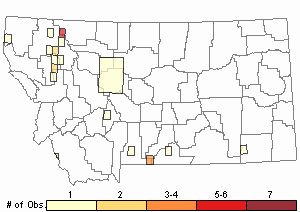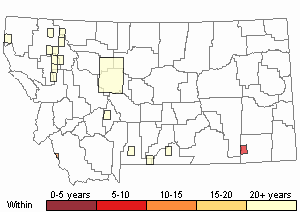View in other NatureServe Network Field Guides
NatureServe
Montana
Utah
Wyoming
Idaho
Wisconsin
British Columbia
South Carolina
Yukon
California
New York
Pale Nodding Moss - Pohlia wahlenbergii
General Description
Plants: Acrocarpous (FNA 2014), growing in soft, large, open to crowded clumps of upright shoots (Crum and Anderson et al. 1981) or in mats, pale green to green tinged with white (Lawton 1971), occasionally reddish in big plants (FNA 2014) when moist, somewhat ochre when dry, not shiny (Crum and Anderson et al, 1981). Stems 8-100 mm tall (FNA 2014), red, occasionally forked; rhizoids several to many (Lawton 1971).
Leaves: Somewhat remotely spaced on the stem (Crum and Anderson et al. 1981), overlapping, or a little curved and twisted when dry, firmly upright to spreading when damp (FNA 2014), cupped (Lawton 1971), lance-shaped, sometimes with ovate tendencies (FNA 2014), narrowing to the acute leaf tip, sometimes the tip obtuse in proximal leaves (Lawton 1971); leaf edges flat (FNA 2014) or nearly so (Lawton 1971), in the apical region the leaf edges faintly to strongly finely saw-toothed (FNA 2014); base extending down the stem distinctly or slightly (Crum and Anderson et al. 1981); costa red (Lawton 1971), not approaching closely to the leaf tip (FNA 2014).
Leaf Cells: Upper medial laminal cells lax and fine-walled, wide and diamond-shaped to 6-sided (FNA 2014); marginal laminal cells occasionally a little longer and more slender (Lawton 1971).
Phenology
Fruit ripens in spring (FNA 2014).
Diagnostic Characteristics
Plants have a large size range, forming thick cushions in northerly and high-elevation sites to thin, small plants in less favorable climes (FNA 2014).
The red stems amongst the whitish leaves form a high degree of contrast which is recognizable in the field; the whiteness disappears when the plants are dry (Crum and Anderson et al. 1981).
Range Comments
North American Range
Common and widespread (FNA 2014). Canada: In all territories and provinces except unknown in SK; USA: throughout (except unknown in IN, TX, and in the Southeast from AL to SC and FL); Mexico (FNA 2014). Known in Montana from Cascade, Flathead, Gallatin, Glacier, Lake, Lincoln, Park, and Ravalli Counties (Elliott and Pipp 2016).
Observations in Montana Natural Heritage Program Database
Number of Observations: 29
(Click on the following maps and charts to see full sized version)
Map Help and Descriptions
Relative Density

Recency



 (Observations spanning multiple months or years are excluded from time charts)
(Observations spanning multiple months or years are excluded from time charts)
Habitat
Moist (Lawton 1971), fine-textured soil, rarely sandy (FNA 2014), and also on stones (Crum and Anderson et al. 1981); found in disturbed areas, such as path embankments and along watercourses (FNA 2014), in seepy areas and near springs (Crum and Anderson et al. 1981). Occurring from low to high altitudes (Lawton 1971).
Reproductive Characteristics
Dioicous. Perigonial bracts egg-shaped (FNA 2014), terminal. Seta 10-20 mm tall, red (Lawton 1971) or brown and tinged with orange, solitary. Capsule carried well-beyond the perichaetial bracts, somewhat russet to brown, occasionally straw-colored, drooping vertically or nearly so, short and pear- or urn-shaped (FNA 2014) to ovoid; theca including neck 0.75-2 mm in length; neck short (Lawton 1971); stomata sunken (FNA 2014); exostome teeth pale brown to russet, deltoid, pitted below (FNA 2014), papillose (Lawton 1971); endostome processes yellow to transparent, conspicuously keeled with wide openings on the keel; cilia knobby and long (FNA 2014).
Stewardship Responsibility
References
- Literature Cited AboveLegend:
 View Online Publication
View Online Publication Crum, H.A. and L.E. Anderson. 1981. Mosses of Eastern North America. 2 volumes. Columbia University Press, New York. 1328 pp.
Crum, H.A. and L.E. Anderson. 1981. Mosses of Eastern North America. 2 volumes. Columbia University Press, New York. 1328 pp. Elliott, J.C. and A.K. Pipp. 2018. A Checklist of Montana Mosses (1880-2018). Updated 3 January, 2020. Montana Natural Heritage Program, Helena, Montana. 73 pp.
Elliott, J.C. and A.K. Pipp. 2018. A Checklist of Montana Mosses (1880-2018). Updated 3 January, 2020. Montana Natural Heritage Program, Helena, Montana. 73 pp. Flora of North America Editorial Committee, eds. 2014. Flora of North America North of Mexico. Volume 28. Bryophytes: Mosses, Part 2. Oxford University Press, Inc., NY. xxi + 702 pp.
Flora of North America Editorial Committee, eds. 2014. Flora of North America North of Mexico. Volume 28. Bryophytes: Mosses, Part 2. Oxford University Press, Inc., NY. xxi + 702 pp. Lawton, E. 1971. Moss Flora of the Pacific Northwest. Hattori Botanical Laboratory. Japan: Yamabuki-cho, Shinjuku-ku, Tokyo. 362 pages plus appendices.
Lawton, E. 1971. Moss Flora of the Pacific Northwest. Hattori Botanical Laboratory. Japan: Yamabuki-cho, Shinjuku-ku, Tokyo. 362 pages plus appendices.
- Additional ReferencesLegend:
 View Online Publication
View Online Publication
Do you know of a citation we're missing? Elliot, J. C. 1993. Second checklist of Montana mosses. Unpublished report. U.S. Forest Service, Region 1. Missoula, MT. 45 pp.
Elliot, J. C. 1993. Second checklist of Montana mosses. Unpublished report. U.S. Forest Service, Region 1. Missoula, MT. 45 pp. Flowers, S. 1973. Mosses: Utah and the West. Brigham Young University, Provo, Utah. 567 p.
Flowers, S. 1973. Mosses: Utah and the West. Brigham Young University, Provo, Utah. 567 p. Lawton, E. 1971. Keys for the Identification of the Mosses on the Pacific Northwest. Reprinted from 'Moss Flora of the Pacific Northwest'. Published as Supplement No. 2 of the Journal of the Hattori Botanical Laboratory. Nichinan, Miyazaki, Japan. 66 pp.
Lawton, E. 1971. Keys for the Identification of the Mosses on the Pacific Northwest. Reprinted from 'Moss Flora of the Pacific Northwest'. Published as Supplement No. 2 of the Journal of the Hattori Botanical Laboratory. Nichinan, Miyazaki, Japan. 66 pp. Malcolm, B., N. Malcolm, J. Shevock, and D. Norris. 2009. California Mosses. Nelson, New Zealand: Micro-Optics Press. 430 pp.
Malcolm, B., N. Malcolm, J. Shevock, and D. Norris. 2009. California Mosses. Nelson, New Zealand: Micro-Optics Press. 430 pp. Smith, A.J.E. 1980. The Moss Flora of Britain and Ireland. Cambridge University Press, Cambridge. 705 pp.
Smith, A.J.E. 1980. The Moss Flora of Britain and Ireland. Cambridge University Press, Cambridge. 705 pp. Vitt, D. J. Marsh, and R. Bovey. 1988. Mosses, Lichens & Ferns of Northwest North America. Seattle, WA: University of Washington Press. 296 p.
Vitt, D. J. Marsh, and R. Bovey. 1988. Mosses, Lichens & Ferns of Northwest North America. Seattle, WA: University of Washington Press. 296 p.
- Web Search Engines for Articles on "Pale Nodding Moss"





